The Development and Growth of the European Society of Sonochemistry
Some of this material (history from 1980 till 2015) has been published in the text “Sonochemistry Volume 1 Fundamentals and Evolution” De Gruyter, Berlin, 2023, Chapter 1 pp. 1-78 by T.J. Mason and M. Vinatoru. This chapter also contains greater detail on the general history of the development of sonochemistry.
Events leading up to the formation of ESS
International interest in the effects of ultrasound on chemical reactions expanded rapidly during the first few years of the 1980’s. There were several scientists around the world who were involved in the study of ultrasound in chemistry and this provided a stimulus for the organisation of the first international symposium devoted to Sonochemistry. The organisation was provided by Tim Mason with the help of the sonochemistry group at Coventry Polytechnic in the UK (later, when the polytechnic became a university, the group became the Sonochemistry Centre). The meeting was scheduled in April 1986 as part of a Royal Society of Chemistry (RSC) Annual Meeting at Warwick University. Warwick was a convenient place for the sonochemistry group as it was located on the outskirts of the city of Coventry. It brought together scientists who were at that time active in different branches of sonochemistry, some of whom would go on to become pioneers in this “new” field. The proceedings were published in Ultrasonics 25 (1), 1-64 (1987).
Jean-Louis Luche was one of the speakers at this first Sonochemistry Symposium. He was based at that time at Joseph Fourier University in Grenoble and became a significant figure in the establishment of the European Society of Sonochemistry. In the following year he was also involved in the organisation of a EUCHEM Conference “Unusual Methodologies in Synthetic Chemistry” held between May 10-15th 1987 at the Centre Paul Langevin at Aussois located in the Vanoise National Park in Savoie, France. The conference centre belonged to CNRS (the French National Centre for Scientific Research) and was located in the Alps close to the Italian border. The meeting was very significant because it brought together scientists interested in a range of high energy processes including high pressure and high temperature chemistry as well as sonochemistry. It was here that the idea for the formation of a European Society of Sonochemistry was first discussed. However, it would be another 3 years before it would be established.
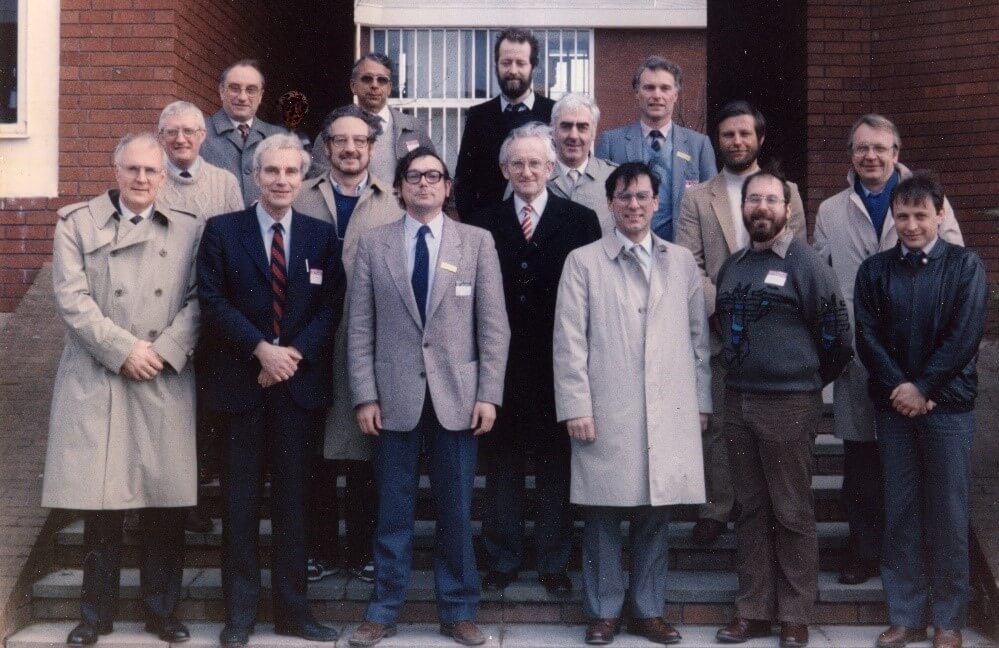
Back row from the left: R. S. Davidson (City University, London, UK), J-L. Luche (Universite de Grenoble, France), B. Pugin (CIBA-GEIGY, Basle, Switzerland), J. P. Lorimer (Coventry Polytechnic, UK)
Middle row from the left: J. Lindley (Coventry Polytechnic, UK), P. Riesz (NIH, Bethesda, USA), T. J. Lewis (University College North Wales, Bangor, UK), J. Perkins (Sonic Systems, Marlborough, UK), E. J. Einhorn (Universite de Grenoble, France), P. Kruus (Carleton University, Ottawa, Canada)
Front row from the left: R. Verrall (University of Saskatchewan, Saskatoon, Canada), A. Henglein (Hahn-Meitner-Institut, Berlin, Germany), T. J. Mason (Coventry Polytechnic, UK), P. Boudjouk (North Dakota State University, Fargo, USA), K. S. Suslick (University of Illinois, Urbana-Champaign, USA), C. Dupuy (Universite de Grenoble, France)
Speakers at the first international symposium on Sonochemistry held at Warwick University UK, 8 to 11 April 1986.
In September 1988, in conjunction with the Royal Society of Chemistry, a Residential Course in Sonochemistry was organised at Coventry Polytechnic entitled “Sonochemistry: the uses of ultrasound in chemistry”. It involved both lectures and laboratory exercises and attracted 56 delegates. Amongst the speakers were Phil Lorimer (Coventry Polytechnic, UK), Tim Mason, Jean-Louis Luche, Jacques Berlan (Ecole National Superieure d’Ingenieurs de Genie Chimique, Toulouse) and Steven Davison (City University, London, UK) who continued discussions on ways in which a future European Society of Sonochemistry could be constituted.
The next major international gathering was a sonochemistry session at Ultrasonics International (UI89) July 3–7 1989 held in Madrid. This was a significant meeting in the UI series because it was the first to include a full session on sonochemistry. After this ground-breaking session all subsequent UI meetings included sonochemistry. The speakers at that session are shown below and in the centre is M. A. (Milia) Margulis from Moscow. It was the first time that he had presented his work in the West but his studies on ultrasound were well known from the literature. His electrical theory on cavitation was to become contentious in later years. This was also the first time that an audience would experience the difficulty that Milia had in keeping his talks within the time limit of a conference presentation. It was always a problem as chairman of a session to stop him. The only time that it worked was at a conference where a low noise would start near the end of a presentation that would slowly grow louder and eventually drown out the speaker’s voice.
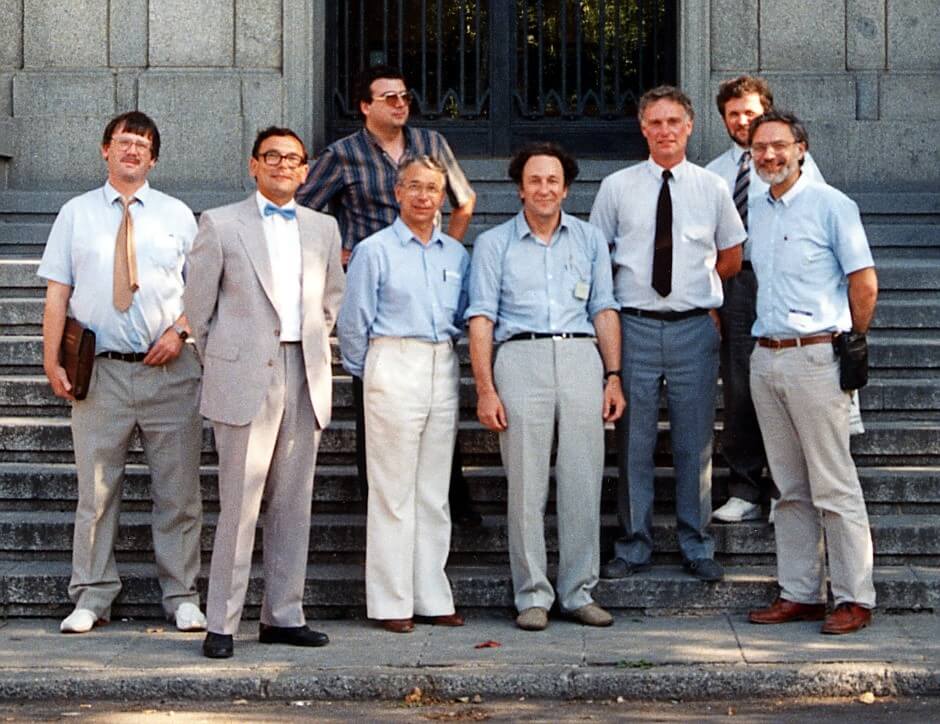
From the left: D. J. Walton (Coventry Polytechnic, U.K.), T. J. Mason (Coventry Polytechnic, U.K.), J. V. Sinisterra (U Complutense, Madrid, Spain), J-L. Luche (University Grenoble, France), M. A. Margulis (Institute of Organic Synthesis, Moscow, Russia), J. P. Lorimer (Coventry Polytechnic, U.K.), A. Chyla (T U Wroclaw, Poland), S. Leeman (Dulwich Hospital, U.K.).
Speakers at the Sonochemistry Session of Ultrasonics International 89 held in Madrid between 3 and 7 July 1989.
Later that same year sonochemistry was included in the Pacific Basin Chemical Societies meeting (Pacifichem 89) held in Hawaii between December 17 to 22 (1989). The meeting was sponsored by the American Chemical Society, the Canadian Society for Chemistry and the Chemical Society of Japan attracting more than 7300 chemists. The sonochemistry section was added for the first time to Pacifichem meetings in 1989. Selected papers were published in Ultrasonics 28 (5), 279-340 (1990).
The formation of the European Society of Sonochemistry
In October of the following year a meeting was organised by Jean-Louis Luche at Autrans near Grenoble in France. This was named as the first meeting of the European Society of Sonochemistry (ESS) but at that stage ESS had not been formally established. The ESS1 meeting provided the framework for all future ESS meetings in that they were all to be run as a single stream (no parallel sessions) and that each would include poster sessions and an exhibition of sonochemistry equipment.
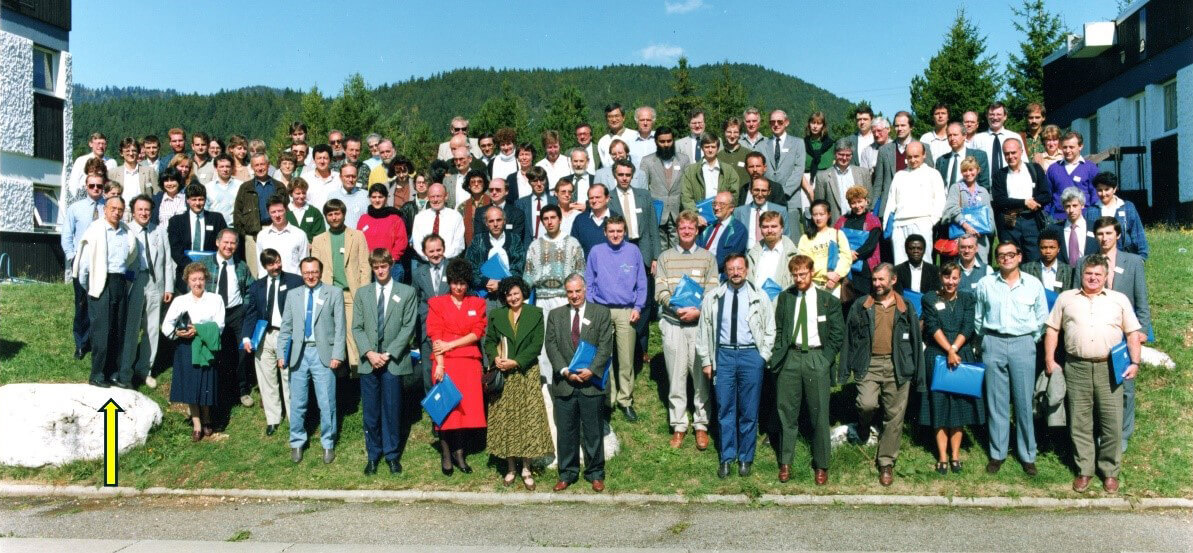
ESS1 at Autrans in France, September 30 to October 4, 1990. Jean-Louis Luche is on the left with his right foot on the rock.
The logo for ESS was developed for the meeting. It was not perfectly drawn but was accepted and used from that point onward. It was based on a benzene ring and was accompanied by its title in 5 languages French, English, German, Spanish and Italian. Two initials of the translations were used in the logo S-E-S (French) and E-U-G (German) and it appeared on the front page of the programme for ESS1. A modification was introduced later at ESS5 in Cambridge when the number of the conference was included in the centre of the logo and this continued at later conferences.

The original Logo for ESS
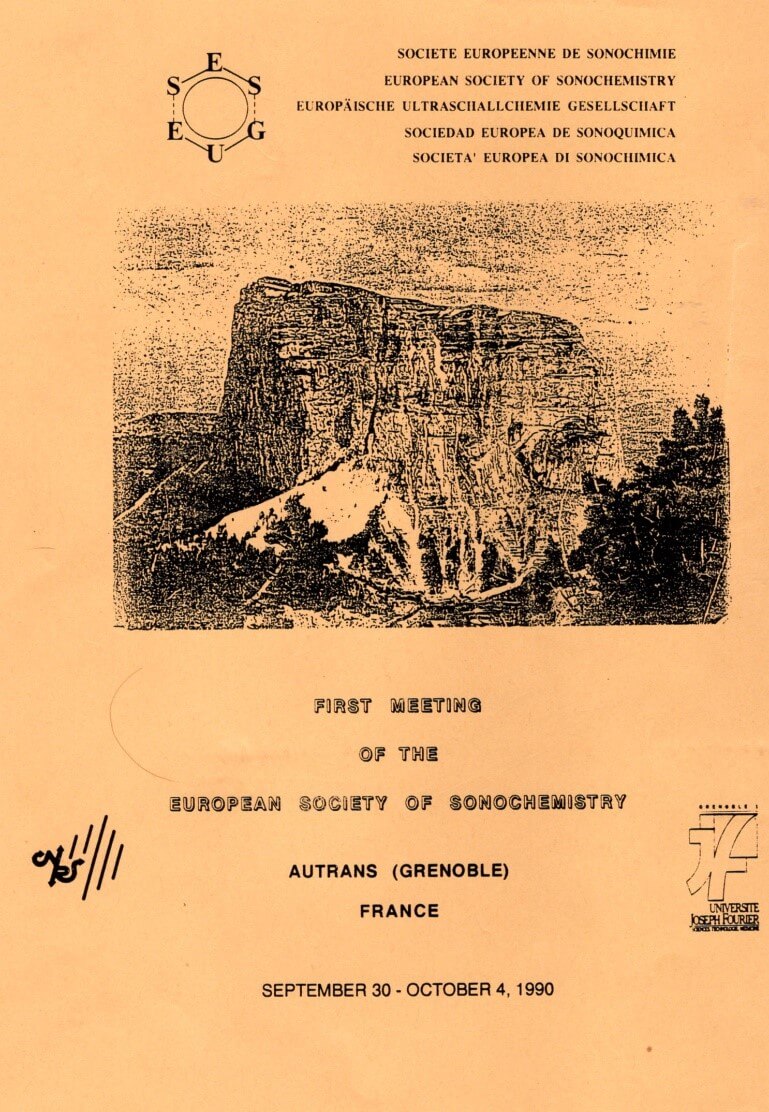
The cover of the ESS1 programme
There were many discussions amongst delegates at that first meeting about the best way to launch ESS and develop the society. Formal arrangements/statutes were required to establish any new scientific society and Jean-Louis Luche volunteered to undertake the task. It was suggested that these should be prepared and decided upon at the next European Sonochemistry meeting which was to be organised by Vittorio Ragaini in Italy in 1992.
ESS2 was held in September 1991 at the villa Palazzo Feltrinelli, in Gargnano (Figure 6}, The venue was owned by the University of Milan and overlooked Lake Garda and selected papers were published in Ultrasonics 30 (3), 147 -200 (1992).
ESS2 was also special in that it incorporated a “School of Sonochemistry” complete with demonstrations of sonochemical effects. It was coordinated by Mircea Vinatoru (C. D. Nenițescu Institute of Organic Chemistry, Bucharest) and included presentations by Adriano Alippi (Istituto di Acustica “O.M.Corbino”, Rome), Jacques Berlan (France), Eric Cordemans (Undatim Ultrasonics, Belgium) and Giovanni Galli (Dipartimento di Chimica Industriale, Messina). The experimental demonstrations were provided by Tim Mason and the Sonochemistry Group from Coventry (UK). Some years later, in June 2011, this concept of the teaching of sonochemistry including laboratory experiments was expanded as part of an Ampere/ESS Summer School held in Avignon (see later).
The first officers elected to the society were Tim Mason as president, Jacques Reisse as vice president (Universite Libre de Bruxelles) and Jean-Louis Luche as organising Secretary. It was decided that the treasurer of ESS should be the president of the latest ESS conference because it would be that conference which would incur the major financial transactions occurring every two years. The first treasurer was therefore Vittorio Ragaini (Università di Milano) and for a few years the treasurer changed with each conference. Jean-Louis Luche was particularly interested in organising the society and its laws and he had circulated by fax (before ESS2) his ideas of the possible statutes of our new society based on those of the European Society for Rare Earths. After the Gargnano meeting, he proceeded to establish ESS based on this French model. We were to find out much later that this model had some restrictions which included the requirement for the bank to be based in France resulting in some on-going problems with membership fees. Nevertheless, the foundations for the European Society of Sonochemistry (ESS) had been sorted out and although the more formal arrangements had been put into place at Gargnano the meeting at Autrans was regarded as the first ever meeting of ESS.
The birth of ESS proved to be a tremendous driving force for the development of sonochemistry – which up until then had been regarded as a relatively new and unexplored branch of chemical sciences. The topics embraced by sonochemistry began to expand beyond its original scope which was “chemistry under the influence of ultrasound” to include many other fields. This was the result of the policy of the ESS scientific board who were open minded about such things. Topics such as ultrasonically assisted extraction, therapeutic ultrasound, food processing, environmental protection together with cavitation theory and sonoluminescence made more regular appearances at subsequent ESS meetings. In due course a dedicated journal was produced for researchers in sonochemistry entitled “Ultrasonics Sonochemistry”.
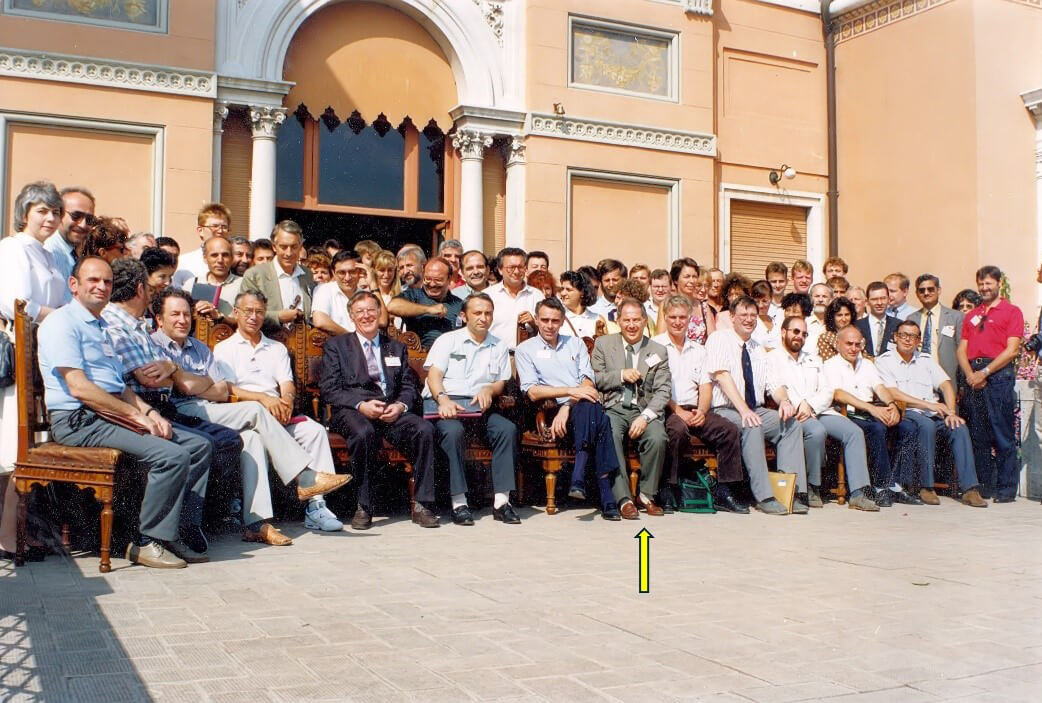
ESS2 at Gargnano in Italy September 15 to 19, 1991. Vittorio Ragaini is in the middle of the front row wearing a grey suit
ESS3 was held during spring in 1993 at the seaside resort of Figueira da Foz in Portugal, with Andre Campos Neves of Coimbra University as president. Selected papers from this meeting were used in the very first issue of the new Elsevier journal Ultrasonics Sonochemistry 1 (1), S3 – S72 (1994).
For the first time in ESS meetings there was a plenary lecture which was dedicated to the use of power ultrasound in medicine given by Nazar Amso (The Royal Victoria Infirmary, Newcastle, U K). His presentation on therapeutic ultrasound in medicine was published in the first issue. It reviewed the topic from the extreme and dramatic effects of externally applied shockwaves in lithotripsy for the destruction of kidney stones, through the delicate use of tiny ultrasonic devices inside arteries for the removal of blood clots to the exciting prospects of focussed ultrasound to be used in cancer therapy.
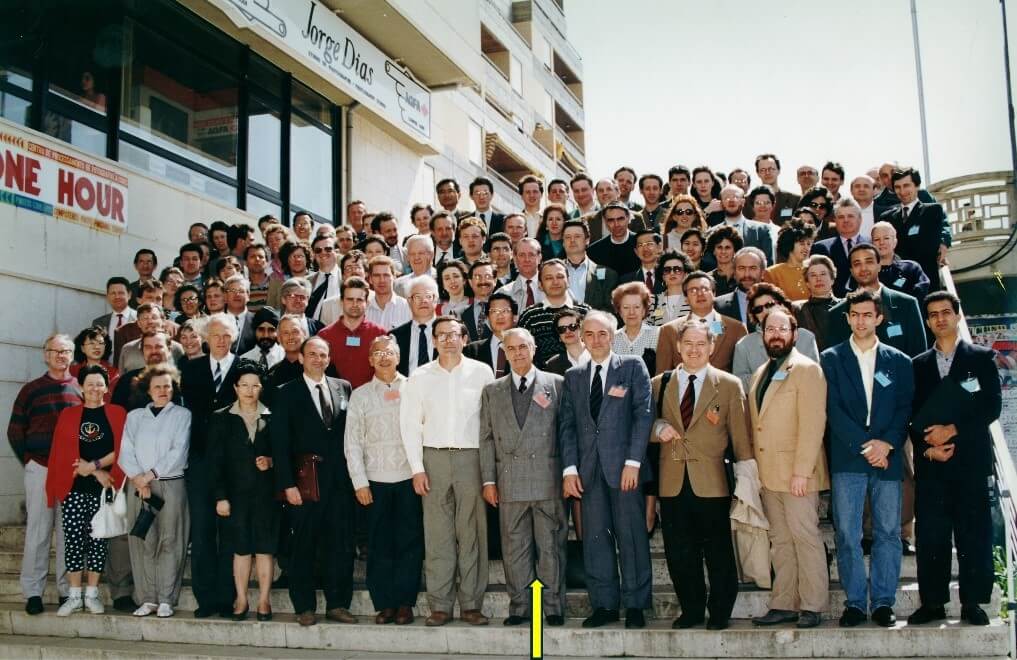
ESS3 at Figueira da Foz in Portugal, March 28 to April 1, 1993. Andre Campos Nevis is 6 from right in the front row
ESS4 was held in spring 1994 at the seaside resort of Blankenberge in Belgium with Jacques Reisse of Universite Libre de Bruxelles as president. Although there was no special edition of Ultrasonics Sonochemistry dedicated to this meeting, six of the plenary lectures were included together with normally submitted papers in Ultrasonics Sonochemistry 2 (2), (1995).
A COST D6 workshop was held as an extra day added to ESS4 which was entitled “Fundamentals of Cavitation” and Jacques Reisse was instrumental in the organisation of this and several subsequent COST meetings. The principle of “Open Seminars” was introduced at this meeting which meant that enough time was to be made available to discuss any relevant scientific topic together with any subsequent unrestricted exchanges of views. The point was made that any proposed ideas could be challenged or criticised but the person who formulated them must not be criticised. Under these circumstances courtesy to the speakers must therefore be maintained at all times.
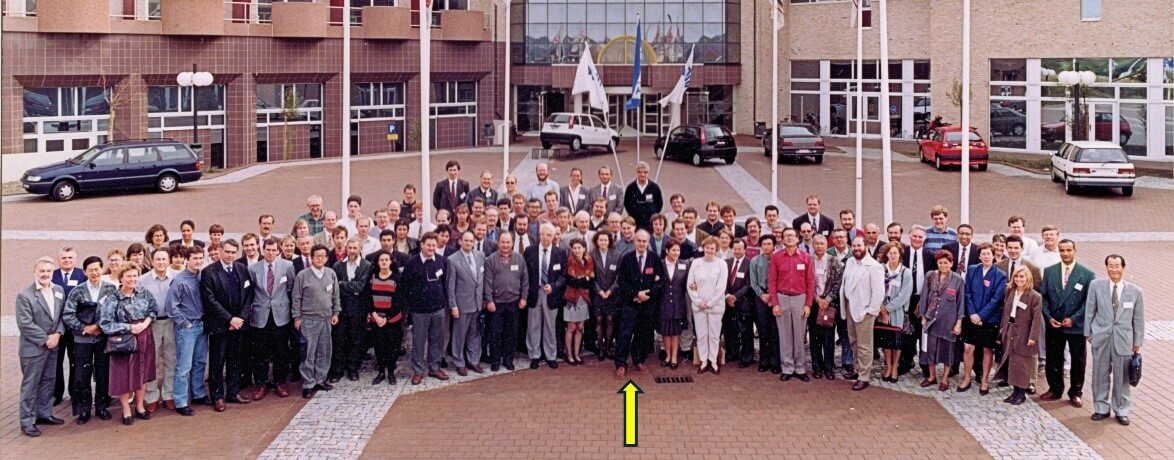
ESS4 at Blankenberge in Belgium, September 18 to 22, 1994. Jacques Reisse is in the front centre of the picture
ESS5 was held in Cambridge UK in 1996 at St John’s College with Tim Mason as president. Selected papers were published in Ultrasonics Sonochemistry 4 (2), 61–221 (1997).
The growing interest in medical ultrasound and the positive response to its inclusion in ESS3 persuaded the organising committee to arrange a one-day session to be dedicated exclusively to therapeutic ultrasound. One half of the therapeutic ultrasound day was made an integral part of the conference programme. However, because the committee was reasonably sure that not all delegates would want more than this, the second half of the medical day was “optional” with delegates having the opportunity to choose between attending the afternoon therapeutic session or going on one of the several available conference excursions. Due to this unusual arrangement additional delegates, not attending ESS5 who were interested mainly in the medical aspects of ultrasound, could enrol only for that one full day rather than the whole meeting.
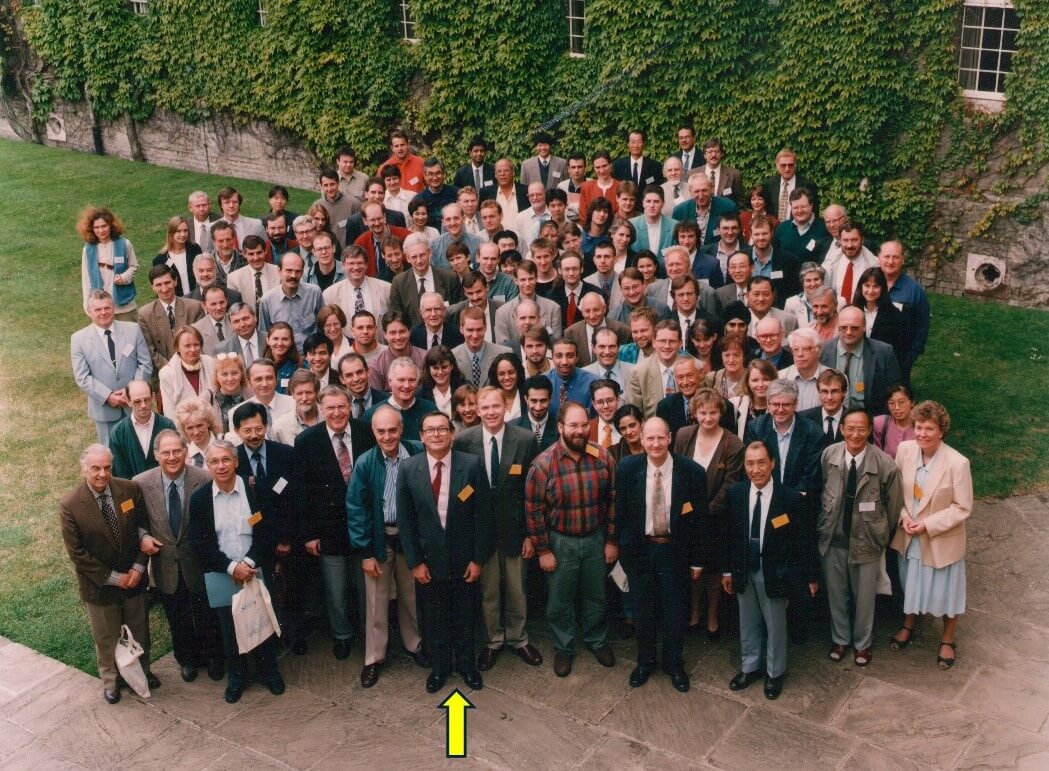
ESS5 at St John’s College, Cambridge in UK, July 7 to 11, 1996. Tim Mason is in the front centre of the picture.
ESS6 was held in Warnemünde a seaside resort which is a district of the city of Rostock in Germany in 1998 with Ralf Miethchen (Universität, Rostock) as president. Selected papers were published in Ultrasonics Sonochemistry 6 (1-2), 1–132 (1999).
At this meeting a new section was added preceding the poster sessions. This was a trial of “one slide per poster” during which each presenter could highlight very briefly the content of their poster in one slide or one overhead. It proved very difficult to restrict the time taken for each presentation and so it did not prove popular with delegates.
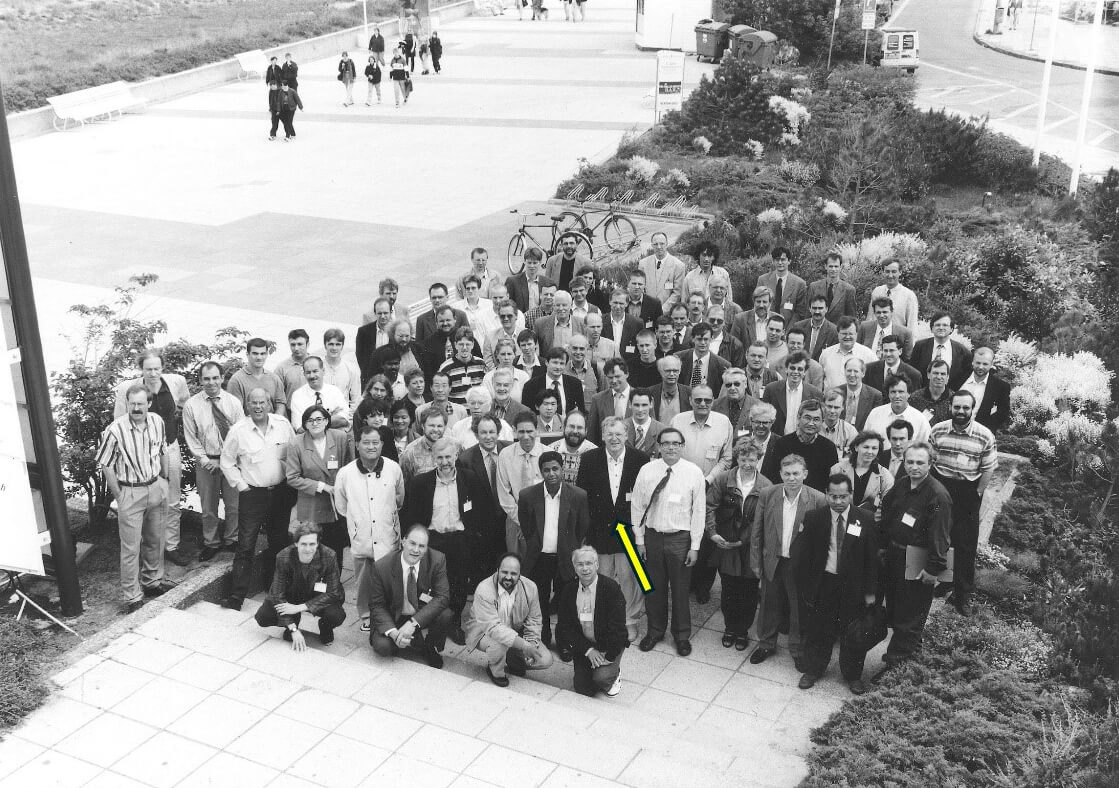
ESS6 at Warnemünde in Germany, May 10 – 14, 1998. Ralf Miethchen is in the centre of the third row.
ESS7 was held in Guéthary (France) a seaside resort near Biarritz between 14-18th May 2000 with Henri Delmas (Ecole Nationale Supérieure de Génie Chimique, Toulouse) as president. Selected papers were published in Ultrasonics Sonochemistry 8 (3), 159–330 (2001).
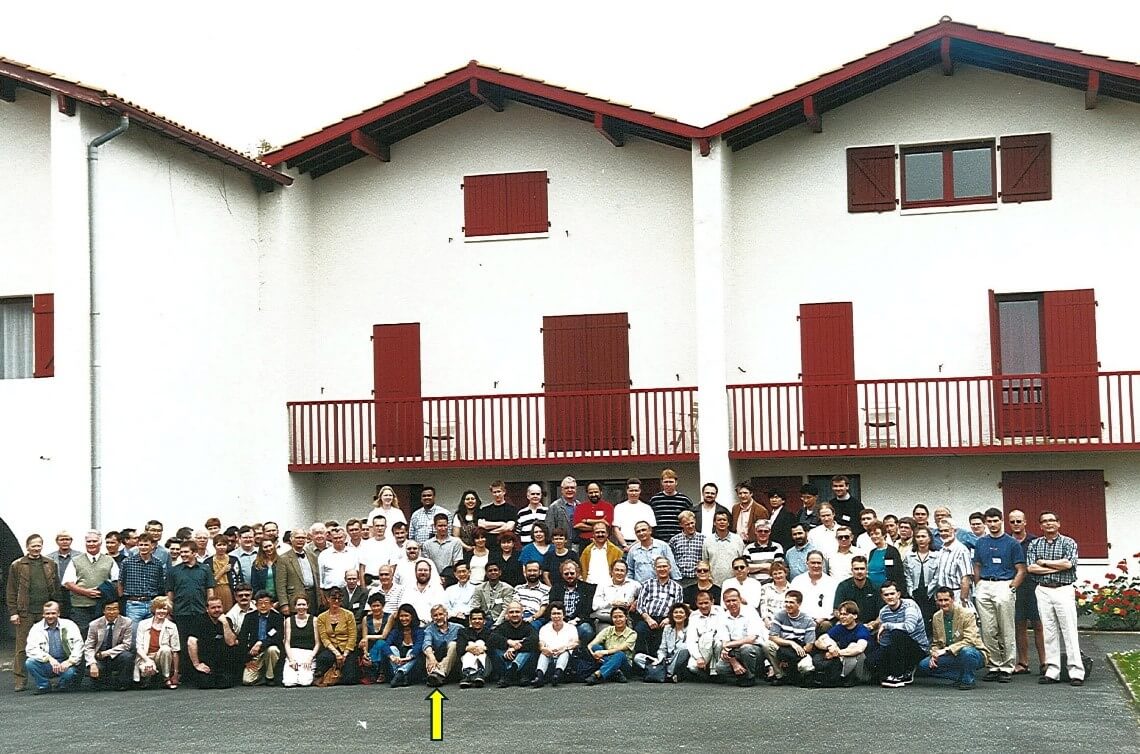
ESS7 at Guéthary in France, May 14-18, 2000. Henri Delmas is twelfth from the right in the front row)
ESS8 was held in Villasimius, (in Southeast Sardinia 35 Km from Cagliari) a seaside resort in 2002 with Vittorio Ragaini as president. Selected papers were published in Ultrasonics Sonochemistry 10 (4-5), 175–308 (2003).
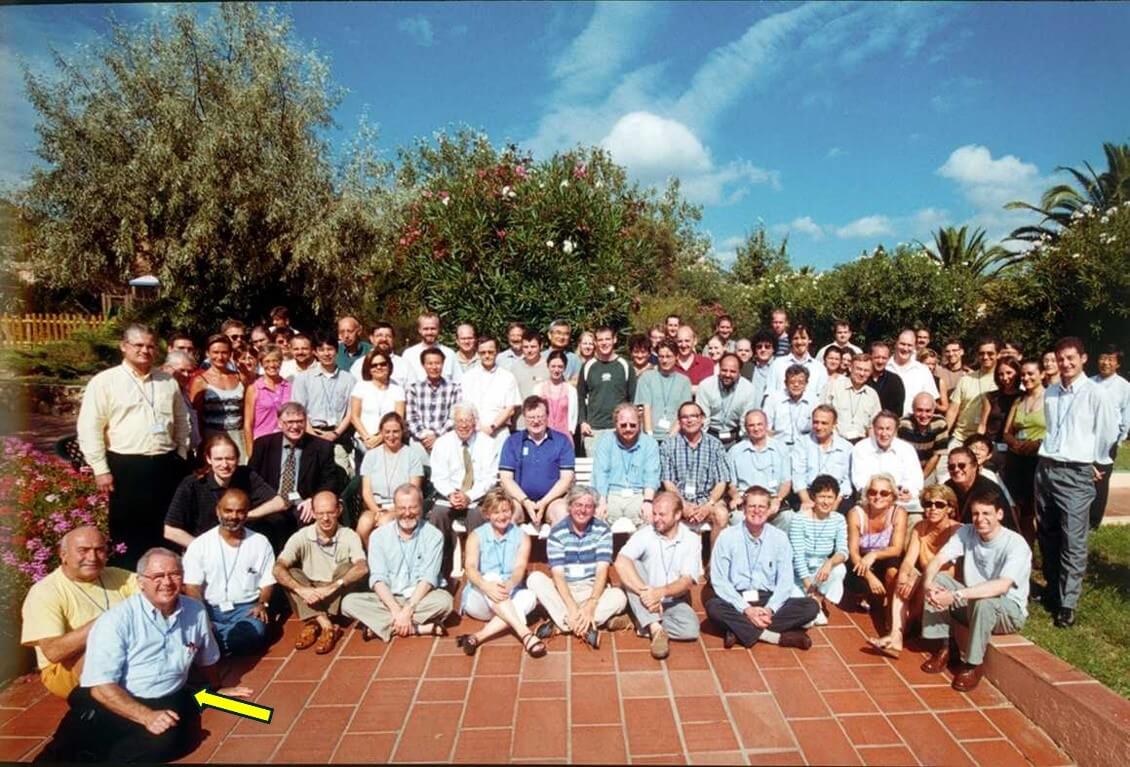
ESS8 at Villasimius in Sardinia 14-19 September 2002. Vittorio Ragaini is sitting at the front second from left
ESS9 was held in Badajoz (Spain) 2004 with Pedro Cintas as president. Selected papers were published in Ultrasonics Sonochemistry 12 (1-2) 1-146 (2005).
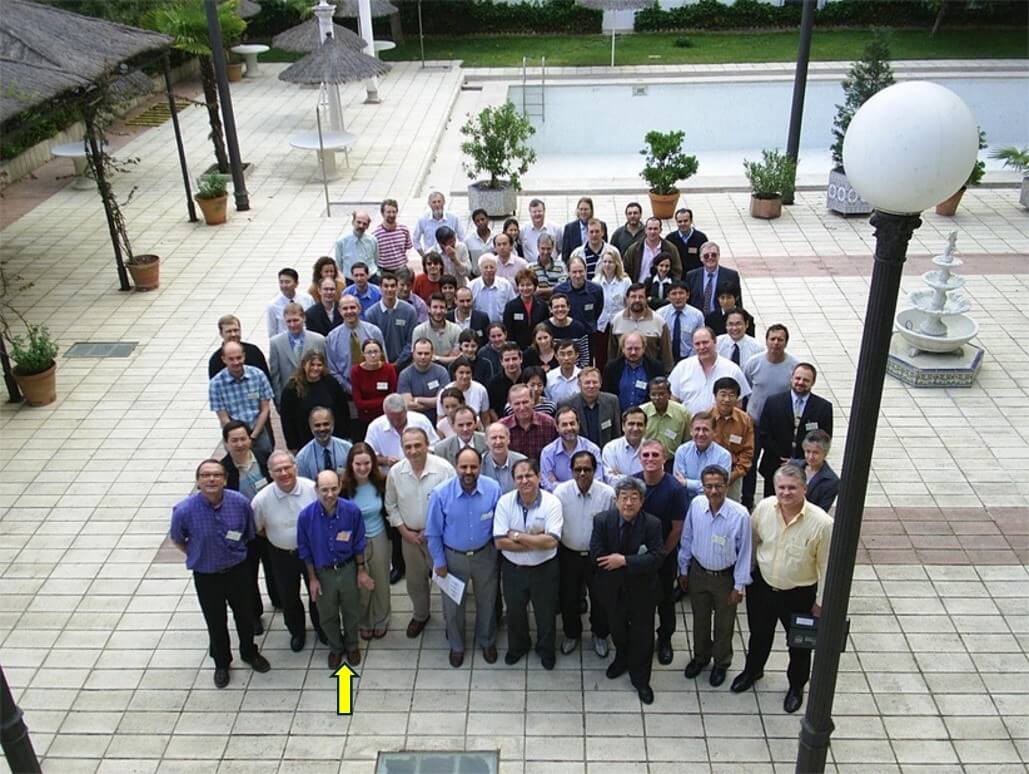
ESS9 at Badajoz in Spain April 25-30, 2004. Pedro Cintas. is in the front third from the left
ESS10 was held in Hamburg (Germany) 2006 with Uwe Neis as president. Selected papers were published in Ultrasonics Sonochemistry 14 (4) 405-492 (2007).
It was at this meeting that it was suggested that two student prizes for best poster should be named as the Jean-Louis Luche prizes. This would be awarded to the students who had contributed most to their poster and would include free renewal of ESS membership for the following year. Two members of the ESS committee were delegated to decide upon the award. Two posters were identified and the student most responsible for producing the work in each were announced at the end of the ESS10 conference. The first two recipients of the prizes were Julien Estager from Universite de Savoie, France for P18: Ultrasound-Assisted Benzoin Condensation in Room-Temperature Ionic Liquids (Estager, Julien; Lévéque, Jean-Marc; Turgis, Raphael; Legeai Sophie; Draye Micheline) and Claudia Domini Universidad Nacional del Sur, Argentina for P20: Monitoring the Oxidation of Vegetable Oil by Ultrasound-Assisted-ATR-FTIR Spectroscopy (Canals. Antonio; Grané, Nuria; Martin, M. Luisa; Roman, Ivan; Staykova, Milena; Domini Claudia)
A mid-term evaluation workshop for COST ACTION D32 was held as a satellite event after the 10th Meeting of the European Society of Sonochemistry. The presentations, involving sonochemistry, microwaves and electrochemistry provided updates from the various working groups.
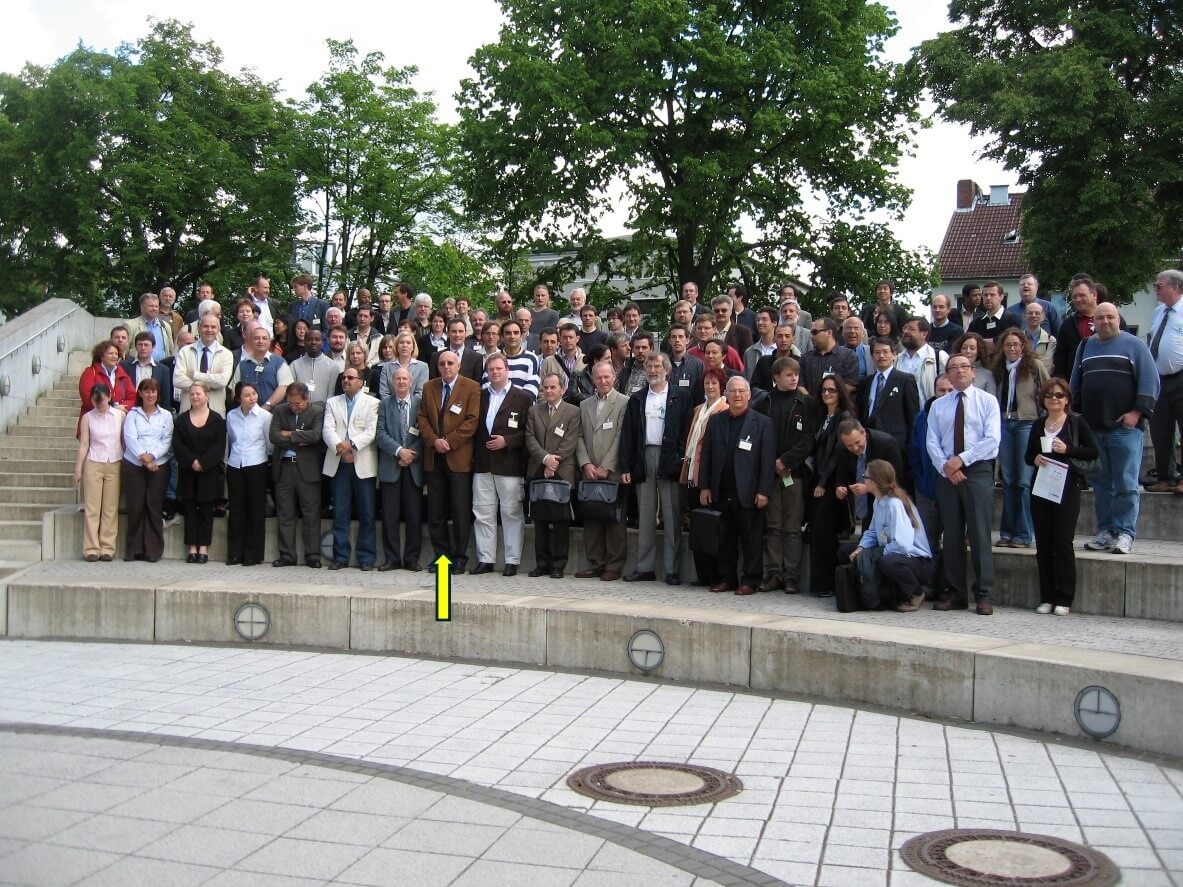
ESS10 at the Technical University of Hamburg-Harburg in Germany June 4-8, 2006. Uwe Neis is in the front eight from the left
ESS11 was held at La Grande Motte (France) in 2008 with Jean-Yves Hihn as president. There was no special issue of Ultrasonics Sonochemistry relating to this conference.
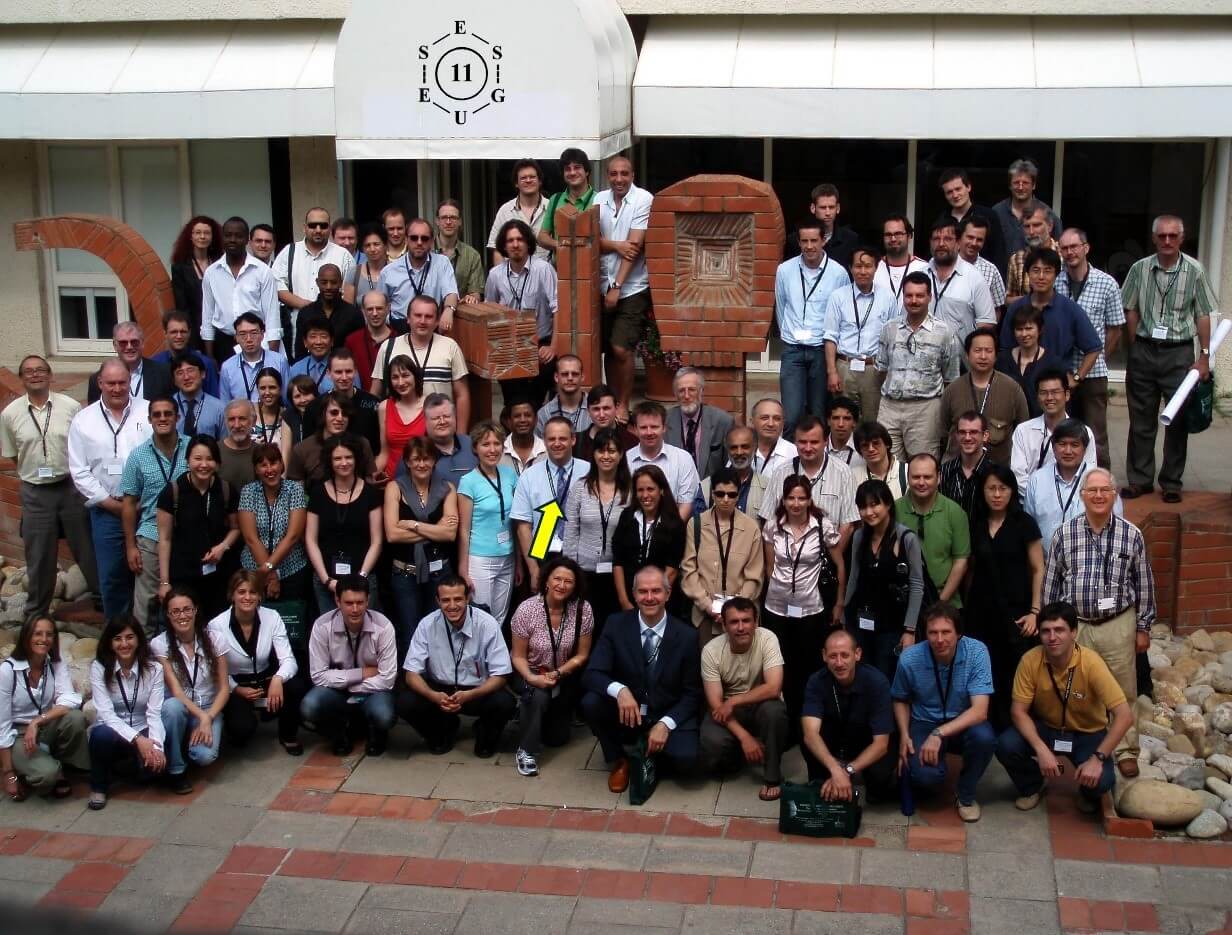
ESS11 at La Grande Motte in France June 1-5, 2008. Jean-Yves Hihn is standing in second row six from the left.
ESS12 was held in Chania, Crete 2010 with Christos Argirusis as president. the volcanic ash plume from the Eyjafjallajökull eruption in Iceland coincided with this meeting and hampered some air flights.
Selected papers were published in Ultrasonics Sonochemistry 18 (4) 811-910 (2011). This issue was dedicated to Anne-Marie Wilhelm and to Oleg Abramov who were both strong supporters of ultrasonics research and had passed away between ESS10 and ESS11. Oleg died in September 2008 and Anne-Marie Wilhelm (Ecole National Superieure d’Ingenieurs de Genie Chimique, Toulouse) was a passenger on flight AF447 from Rio de Janeiro to Paris that was lost over the Atlantic in June 2009.
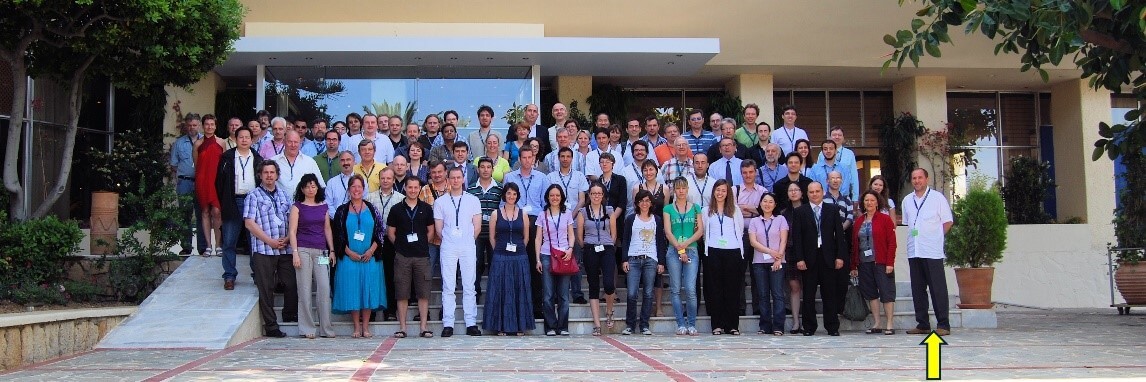
ESS12 at Chania in Crete May 30 – June 3, 2010. Christos Argirusis is standing on the extreme right.
In the following year, 2011, the first ESS and AMPERE Summer School in High Energy Processing Ultrasound and Microwave Technologies, was arranged. Some links between the two organisations had been established in 2009 at a GPE-EPIC conference held in Venice with a joint presentation by Cristina Leonelli (Università di Modena e Reggio Emilia) and Tim Mason entitled “Microwave and ultrasonic processing: Now a realistic option for industry”.
The Summer School location was the University of Avignon because it was there that Farid Chemat (Laboratory for green extraction techniques of natural products, University of Avignon) had created excellent facilities for experimental work in both sonochemistry and microwave technology. The meeting was formally approved by both the ESS board and Cristina Leonelli, on behalf of the AMPERE organization. Eadaoin Joyce who was Head of Environmental Sonochemistry section of the Coventry Sonochemistry Centre agreed to coordinate the meeting which attracted 40 attendees.
In addition to the lectures and laboratory exercises in Avignon the last day of the meeting included a visit to the Marcoule Institute in Separation Chemistry some 35 Km away. This visit was arranged by Sergei Nikitenko and his research team.
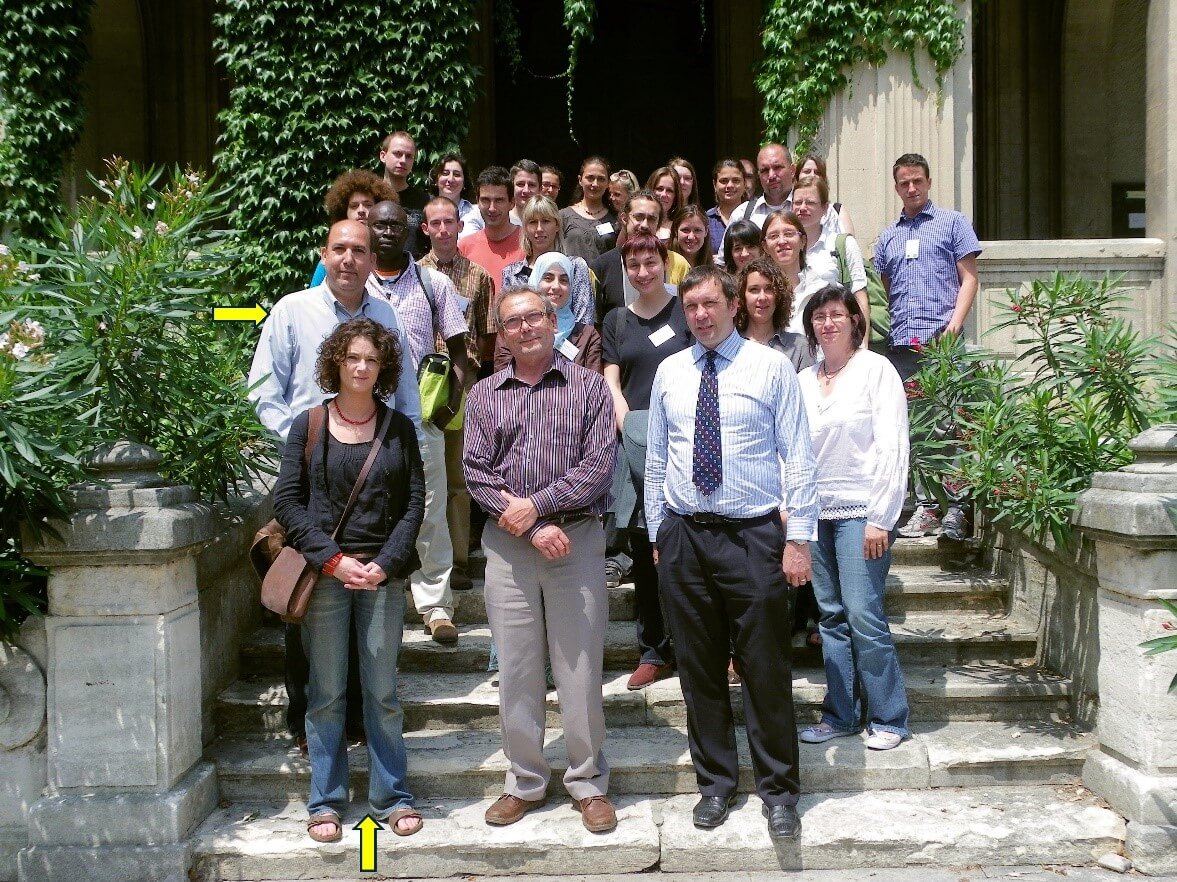
First ESS/AMPERE Summer School at Avignon in France June 6-10, 2011. Eadaoin Joyce is standing front left and Farid Chemat is behind her.
ESS13 was held at Lviv Polytechnic National University, Ukraine 2012. with Volodymyr Starchevskyy as president. The financial arrangements for this meeting were complicated by the fact that it was not possible to use directly either a Ukrainian bank or the university for conference fee transactions. Instead, an arrangement was set up through an intermediary (GALEXPO) to transfer the “PayPal” money collected from delegates online. In the end there was a shortfall which, with the agreement of the board of ESS, was transferred from the ESS bank account. Despite this the conference proved to be a great success with over 100 attendees. There was no special issue of Ultrasonics Sonochemistry relating to this conference.
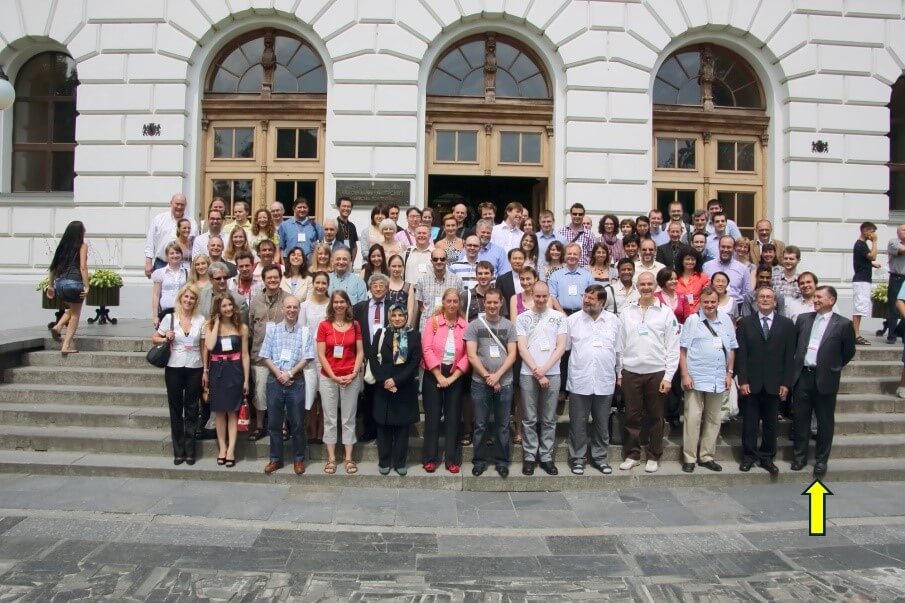
ESS13 was held at Lviv in Ukraine July 1-5, 2012. Volodymyr Starchevskyy is standing on the extreme right.
A second Summer School was held at Dipartimento di Scienza e Tecnologia del Farmaco (DSTF), University of Turin, Italy June 3-7, 2013, organized by Giancarlo Cravotto (DSTF, University of Turin).
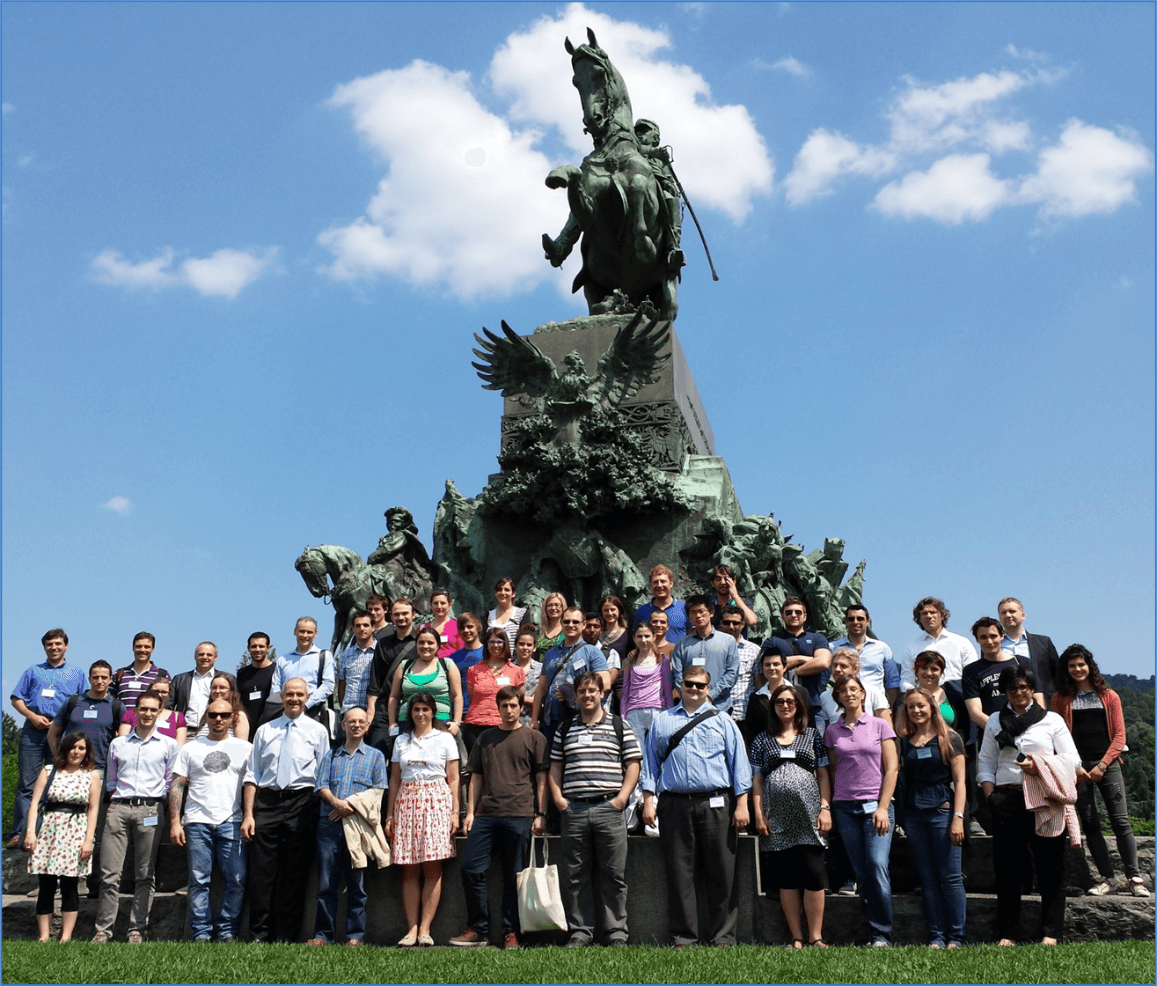
The Summer School in Turin in 2013. Giancarlo Cravotto is fourth from the left on the first row
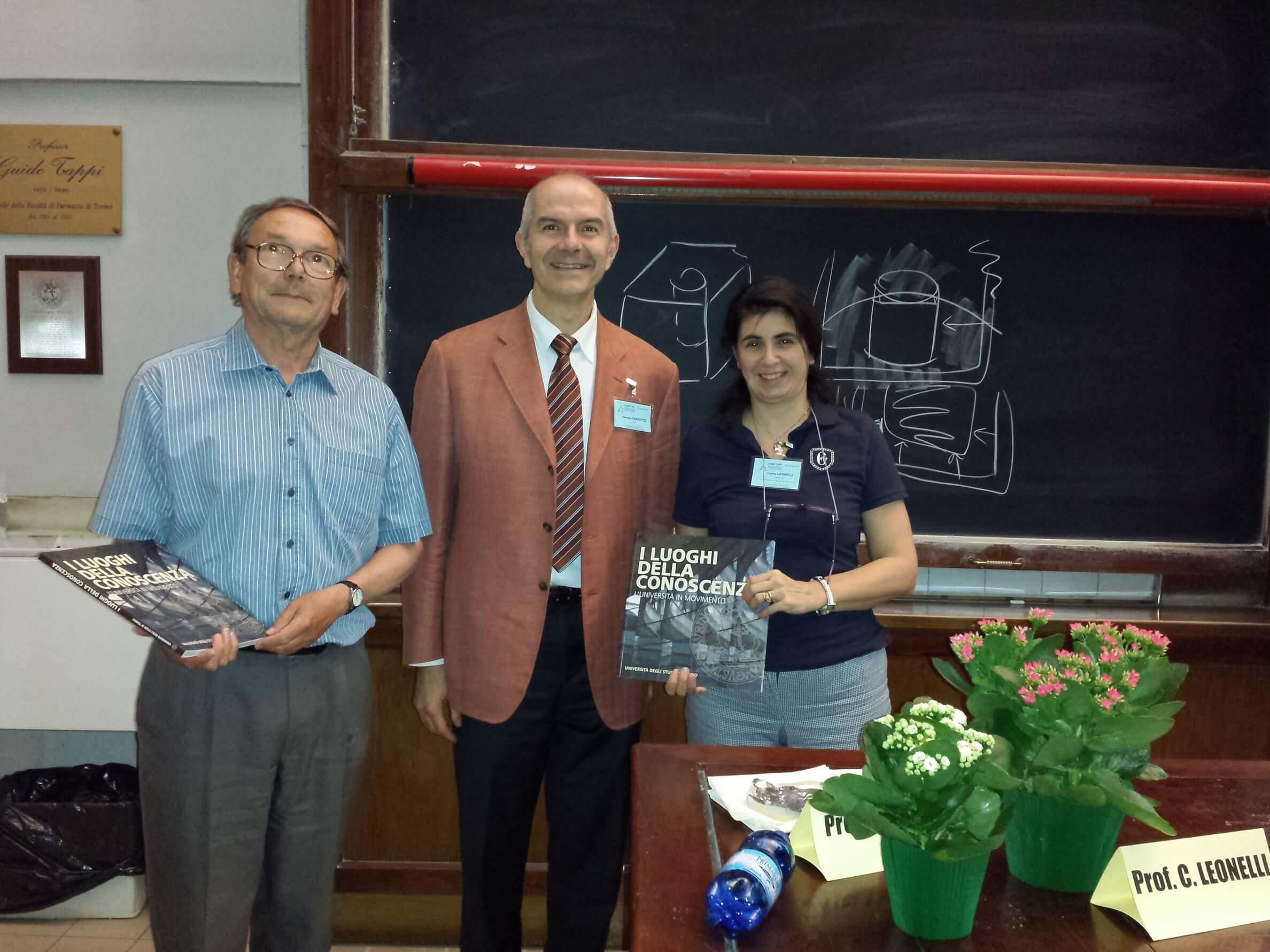
Organizer of the Summer School 2013 Giancarlo Cravotto with Tim Mason (then president of ESS) and Cristina Leonelli (then president of AMPERE)
ESS14 was held in Avignon, France, 2014 jointly chaired by Farid Chemat (University of Avignon) and Sergey Nikitenko (ICSM Marcoule).
Selected papers from ESS14 were published in Ultrasonics Sonochemistry, 25 (1) 1-96 (2015). This issue was dedicated to the memory of Jean-Louis Luche who passed away March 24th, 2014, aged 73. An article In memory of Jean-Louis Luche was published as part of this Special Issue.
In this conference, Tim Mason was succeeded by Giancarlo Cravotto as President of the ESS.
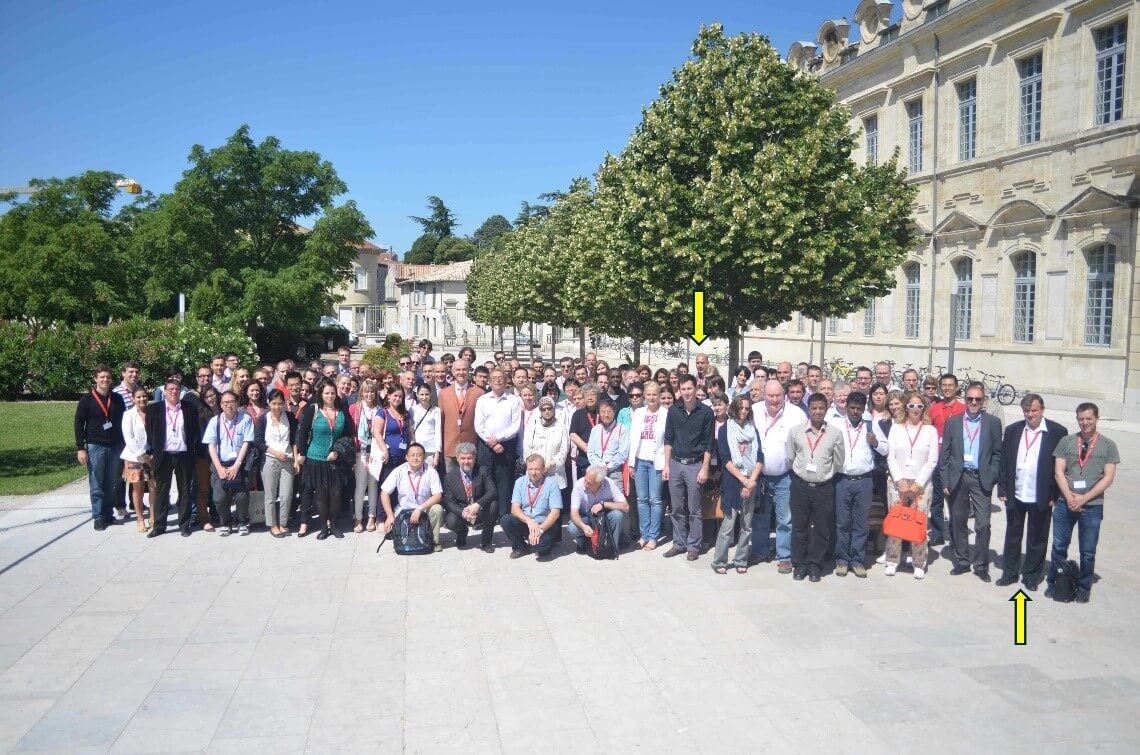
ESS14 was held at Avignon in France June 2-6, 2014. Farid Chemat is at the back under the trees and Sergey Nikitenko is second from the right
In 2015 the third Summer School was held at the Faculty of Chemical Engineering and Technology in Cracow University of Technology, Poland on September 9-12, 2015.
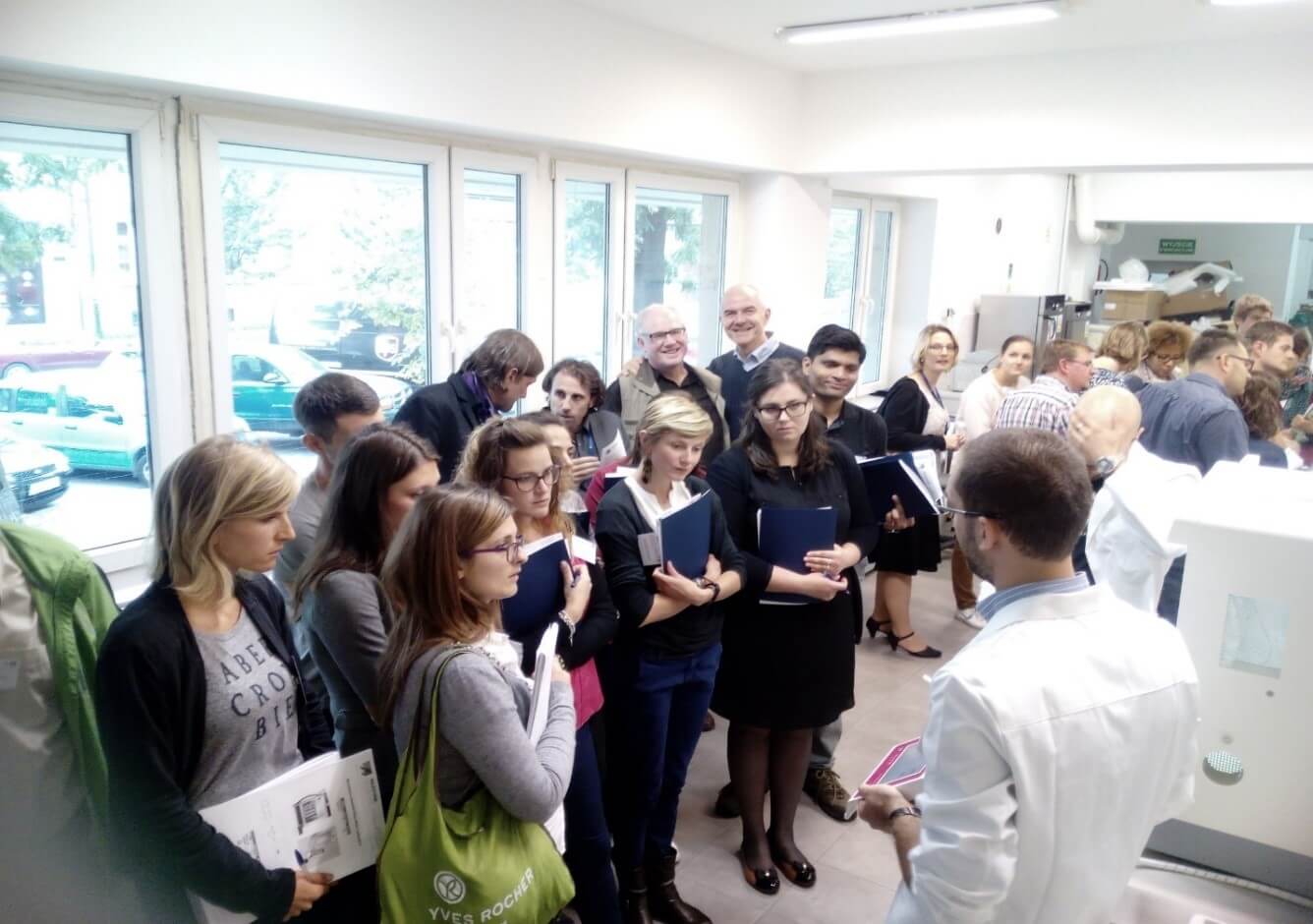
Summer School 2015 in Krakow
ESS15 was held at Istanbul in Turkey from 27 June to 1 July 2016, chaired by Nilsun Ince (Boğaziçi University, Istanbul). Just before the conference started, Istanbul Airport suffered a terroristic attack, making many participants arriving with some delay at the conference. This was more than made up by the magnificent boat trip on the Bosphorus during the social event.
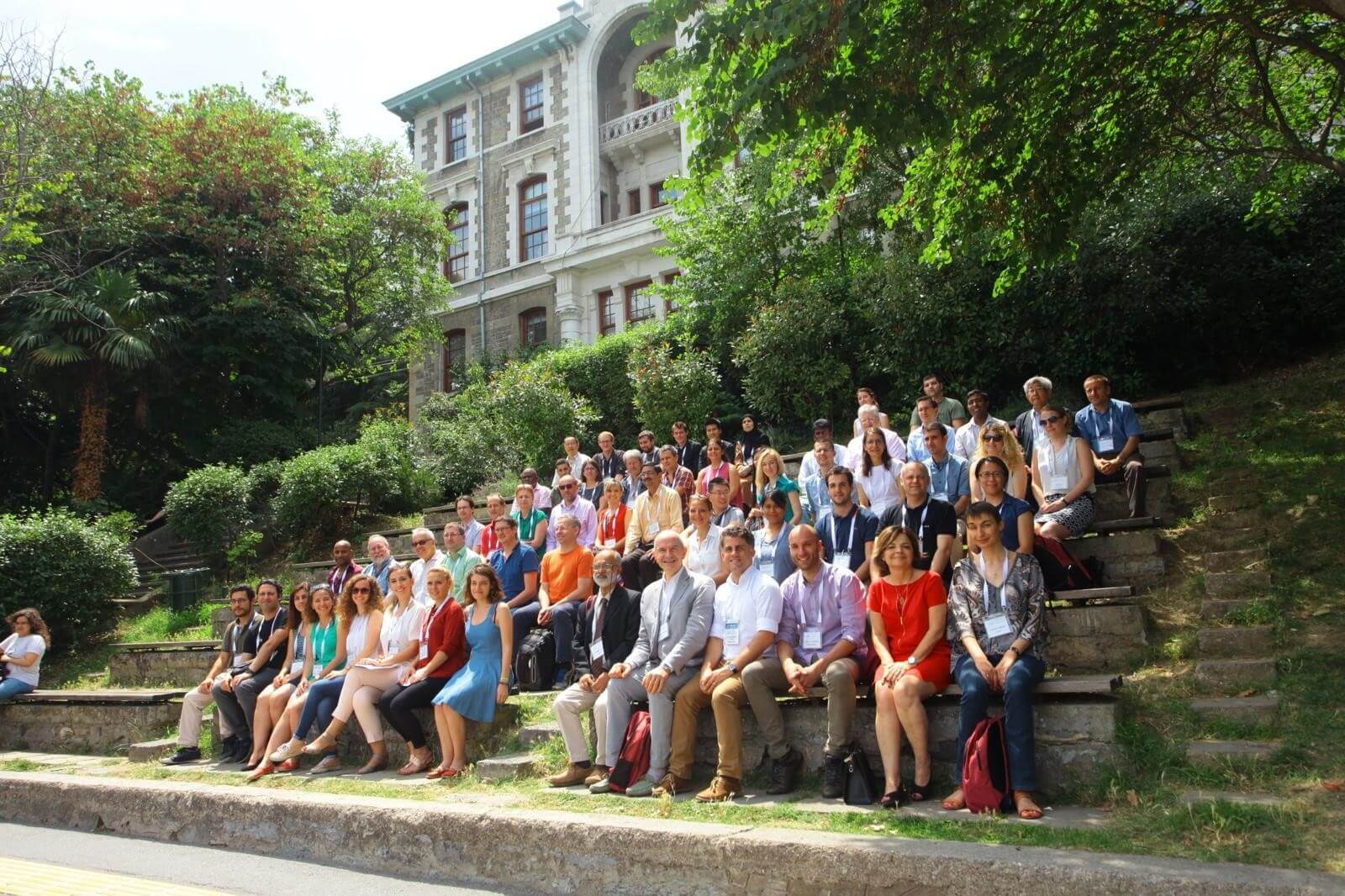
ESS15 was held in Istanbul. Nilsun Ince is on the first row, second to the right
In 2017 the fourth Summer School was held from 4-8 September at the Department of Chemical Engineering in KU Leuven, Belgium.
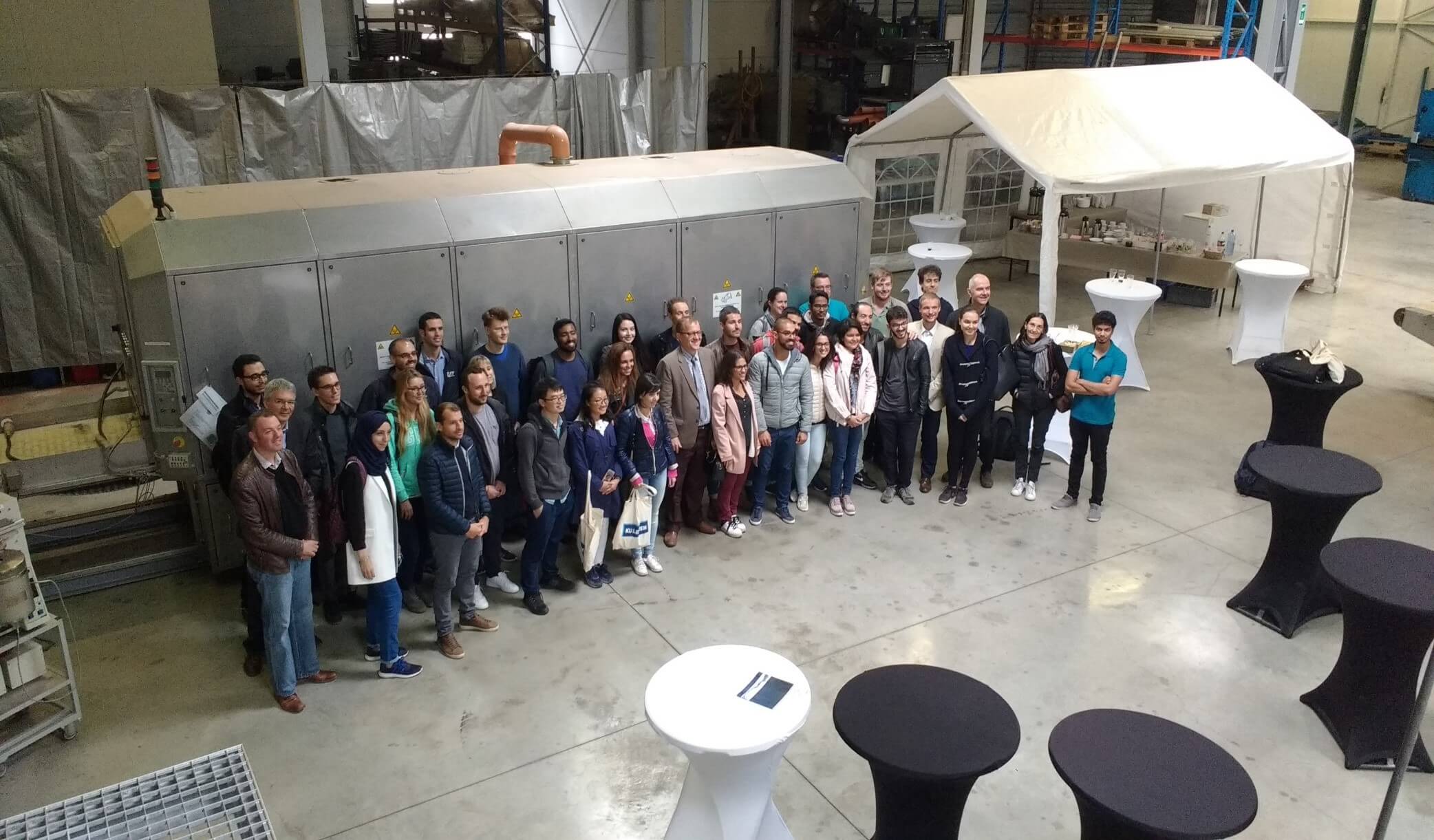
Summer School 2017 in Leuven.
ESS16 was held at Besancon in France from 15 to 19 April 2018; chaired by Jean-Yves Hihn (Institut UTINAM, Université Franche-Comté, Besancon, France). Jean-Yves also became the new President of the ESS, succeeding Giancarlo Cravotto.
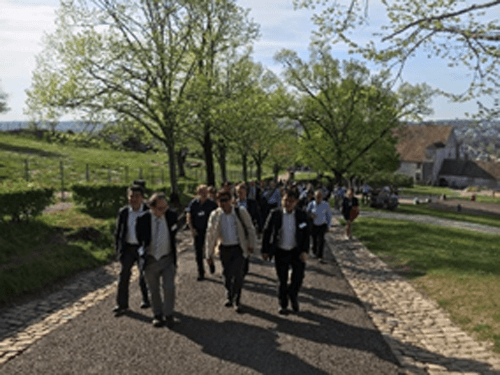
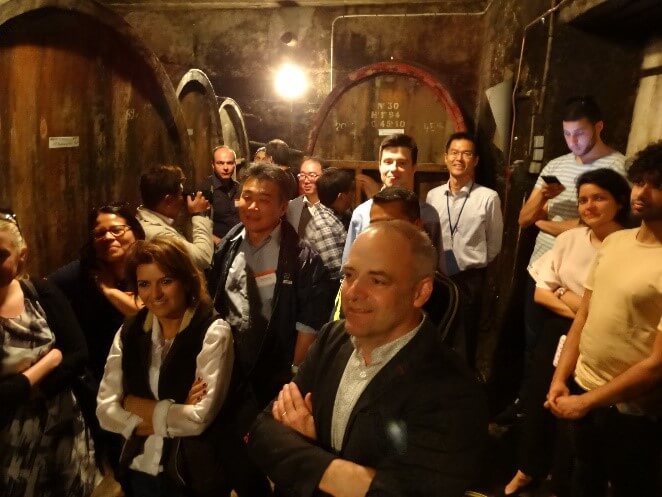
ESS16 was held at Besancon (France) in 2014. Jean-Yves Hihn is in the front of the picture of the wine tasting event.
In June 2019 the Summer School in High Energy Processing, Ultrasound & Microwave Technologies, was organized in Cracow, Poland.
The next ESS conference was set to be held in 2020. However, the Covid crisis hit the world throughout 2020 and 2021, making it impossible to hold physical meetings. Therefore, in November 2021 ESS organized together with the Japanese Society of Sonochemistry and the Asia-Oceania Sonochemistry Society the 1st joint online meeting. In total 250 people registered and an average number of approximately 140 people connected simultaneously, which made it a great success.
ESS17 was held, with 2 years of delay, at Jena in Germany from 8 August – 1 September 2022, chaired by Patrick Bräutigam (Center for Energy and Environmental Chemistry, Jena). Tim Mason received the 2nd Alfred L. Loomis Award for Research Excellence. It was the first physical ESS gathering after the Covid crisis. You can clearly see from the picture that everyone was happy to get together again.

ESS17 was held at Jena in Germany August 8 – September 22, 2022. Patrick Bräutigam is close to the stairs with the black backpack.
ESS18 was held at Leuven in Belgium from 27 – 31 May 2024, chaired by Tom Van Gerven (Process Engineering for Sustainable Systems, KU Leuven). At the opening of the conference Muthupandian Ashokkumar, known in the community as Ashok, received the 3rd Alfred L. Loomis Award for Research Excellence. Giancarlo Cravotto, in his plenary speech, commemorated Farid Chemat and Vladimir Abramov who passed away on 27 January 2024 and on 14 November 2022, respectively. Tom Van Gerven succeeded Jean-Yves Hihn as President of the ESS.
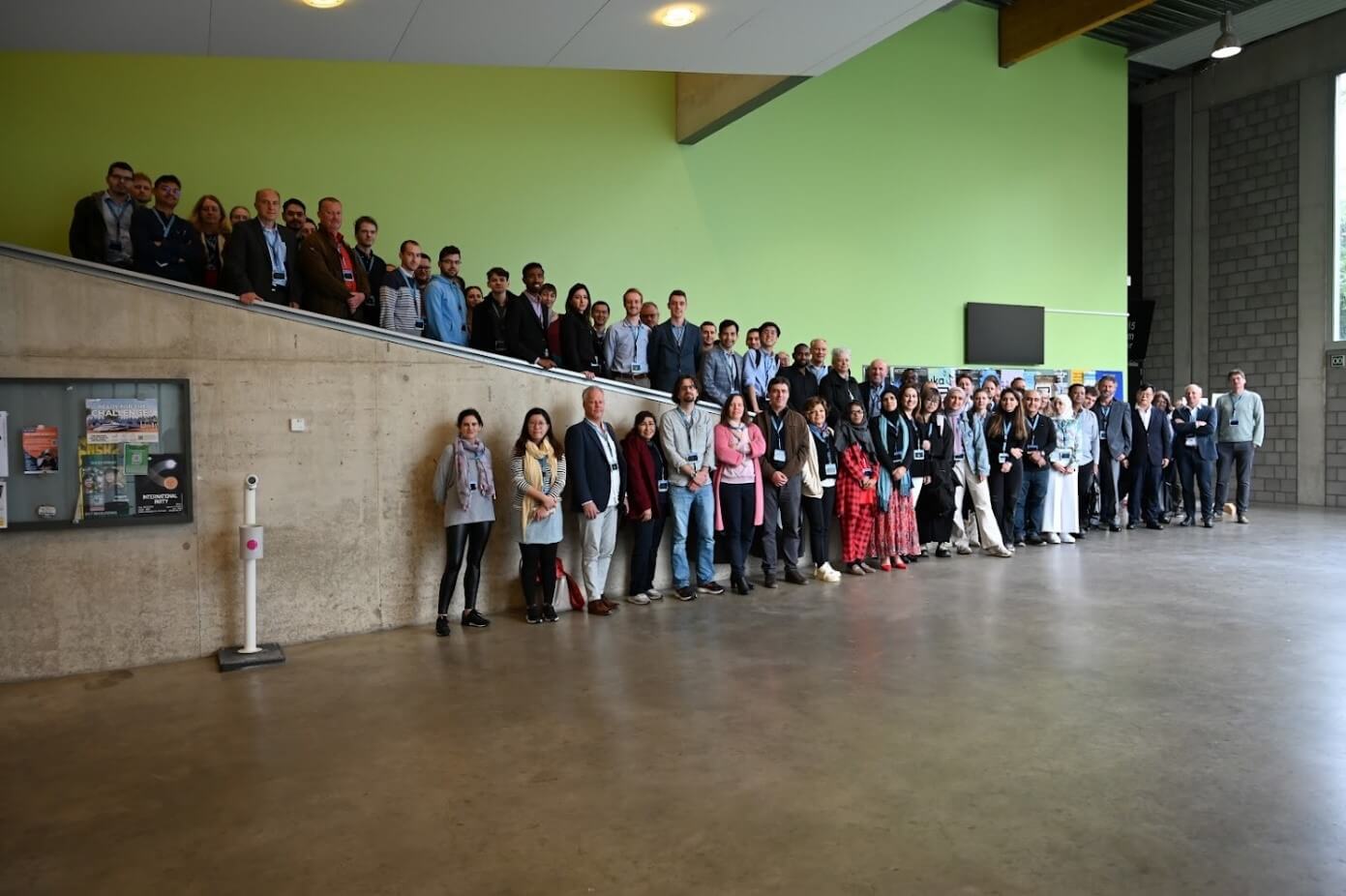
ESS18 was held at Leuven in Belgium May 27-31, 2024. Tom Van Gerven is at the far right.
Note: On the first occasion that a scientist’s appears in this text the name will be accompanied by the affiliation of that person at that time. After this only the name will be used.